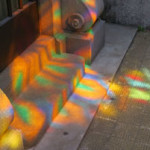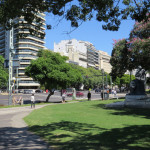BUENOS AIRES; A THOROUGHLY EUROPEAN CITY
BUENOS AIRES; A THOROUGHLY EUROPEAN CITY
By CHANTAL COOKE
Buenos Aires is a European city in almost everything but location. It has the tree lined boulevards of Paris, the café culture of Madrid, the decorative buildings of Milan and the elegant coffee houses and fancy cakes of Vienna.
Ornate buildings peep out between the trees showing off their intricate wrought iron work and shiny door furniture. Stepping inside some of these can be like taking a trip back in time to the days of giant chandeliers, carved wood ceilings, and brass polished to a mirror-like finish. Buenos Aires screams European elegance at every turn.
So needless to say a few hours spent idly drinking coffee and watching the world go by is a must.

Another ‘must’ is the cemetery in the city. It may sound odd, but this isn’t your usual bunch of scruffy looking headstones fighting their way through the moss and weeds. This is a huge area where tombs, mausoleums, giant angels, elegant sculptures, stained glass windows and ornate ironwork plaques fight for space in something that, at first glance, resembles a giant architectural salvage yard. But on closer inspection there is a system to the placing of the dead. A wide avenue takes you to the original centre where tomb lined streets head off in a star pattern. Then as the cemetery grew a grid pattern developed, with every available millimetre used to squeeze in a memorial to a loved one.

Stained glass throws coloured light on the steps. Ornate plaques tell the stories of the people interred there. And dozens of angels keep watch from above. Eva Peron is also buried here and everyone takes a moment to pause by the tomb of Argentina’s most famous first lady.
A guide at the entrance will hand out information, but if you can get a guided tour you will learn so much more – and the guides are passionate about the cemetery. To them, this isn’t just a place for dead people.

There is small park in front of the cemetery where you can stop for a coffee or a delicious dulce de leche ice cream before walking back through among the elegant architecture of the Recoleta district.
As you walk around, look up. The architecture is a mix of late 1800s, elegant art nouveau, crumbling concrete and the shiny glass facades of modern tower blocks. It’s the older buildings that are really worth looking at: the wrought iron work is intricate and artistic; the doors are large and imposing, but always beautiful; and the door furniture ostentatiously calls to you while also making it clear that someone of importance once lived behind this door.

But Buenos Aires is not all buildings and boulevards, it is also full of trees, parks and rose gardens. Thanks to the foresight of Carlos Thays who was appointed Director of Parks & Walkways in 1891, Buenos Aires has hundreds of trees, chosen to ensure that from the start of spring to the end of the autumn the city will always be in bloom. But his vision didn’t stop there, he also included dozens of parks and rose gardens within the city – ensuring that nature was always accessible to the urban inhabitants.
Fact Box:
Hotels:
Caesar Park has a great buffet breakfast and elegant 5 ‘o’clock tea with a wide choice of tea blends and homemade pastries.
Legado Mitico is a small boutique hotel with large rooms, a very private entrance, and a quiet walled garden to relax in.
Palacio Duhau – Park Hyatt is a luxurious hotel steeped in history with its own art gallery, a wine cellar with over 7000 bottles and an in-house cheese specialist.
Travel:
British Airways operates a daily flight to Buenos Aires. Fares start from £912 return including taxes, fees and charges. See: www.ba.com
To arrange your tour to Argentina contact Argentina Travel Partners

About the Author:
Chantal Cooke is an award winning journalist and broadcaster with a passion for the planet. In 2002 she co-founded the award winning radio station PASSION for the PLANET and in 2009 Chantal was awarded London Leader in Sustainability status. Chantal also runs a successful communications agency – Panpathic Communications.
